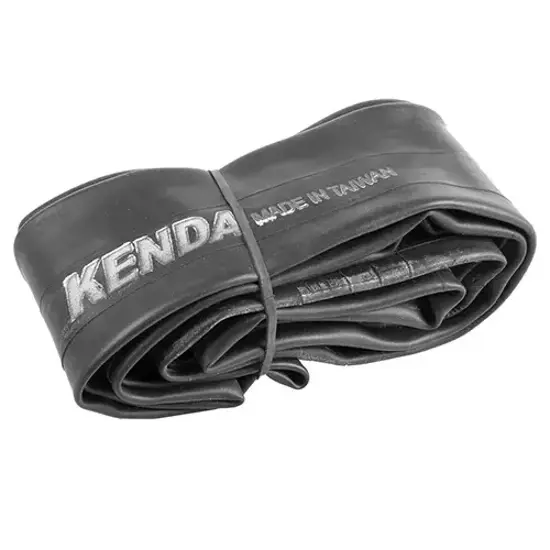10-inch bicycle tubes
Adjust the filters, such as the tube size or valve type, as required to find the right results.
If you would like to expand your result list to include all products, click on the button.
-

![Kenda]() Bicycle tubesKenda54-152 A/V 70°/45° 10x2,00Schrader valve40 mm5.78 €
Bicycle tubesKenda54-152 A/V 70°/45° 10x2,00Schrader valve40 mm5.78 €
10 inch bicycle inner tubes at a glance
10" bicycle inner tubes are a special size often used on children's bikes, balance bikes, children's scooters and some electric scooters. These small tubes are designed to fit well in compact tyres and offer high stability, making them ideal for young riders and vehicles in urban environments. They provide solid air cushioning for a more comfortable ride and better protection against impacts.
A special feature of the 10" tubes is their reinforced construction. Because they are used on vehicles that are often driven over uneven terrain, these tubes are usually made from durable rubber, which ensures a good seal and therefore retains air pressure for longer. Some models also have a puncture protection feature to protect the inner tube from punctures and abrasion, which is particularly useful for intensive use.
Well-known manufacturers of 10" inner tubes include Schwalbe, Kenda and CST. These brands offer high quality inner tubes specifically designed for the needs of smaller bikes and children's bikes. With a Schwalbe, Kenda or CST 10" inner tube, children and e-scooter riders can ride safely and comfortably, whether on short urban routes or in the playground.
Buy 10-inch bicycle tubes at great prices at reifen.com
In addition to 10-inch bicycle tubes, you will also find all standard sizes within our product range, at affordable prices. Our online shop relies exclusively on the high quality provided by a wide range of reputable bicycle tube manufacturers.
Bicycle tube material
Butyl
Butyl is a very elastic, airtight, and synthetic rubber. The weight of a butyl tube depends on the respective area of use. Crucial to the quality of a butyl tube is the ratio in which the additives required for their manufacture are mixed.
Within the racing tyre segment, a butyl tube is no heavier than tubes made of thermoplastic or latex. In the mountain bike segment, this is unfortunately not the case, with butyl hoses adding more weight than products made of thermoplastic or latex.
The air loss with butyl tubes is very low.
The puncture resistance of a butyl tube is generally not so great compared to the tubes made of thermoplastic or latex.
However, one crucial criterion is the price, with butyl hoses actually cheaper than their competitors made from thermoplastic or latex.
Latex
Latex is a very light, very flexible material, which offers exceptional puncture protection. Latex tubes are coated with talcum on the outside, meaning that the tubes do not stick to the tyres. This means that the tube can avoid punctures penetrating through the casing. In this regard, it is recommended that you apply an additional layer of talc in order to increase puncture resistance. However, latex is a highly sensitive material, and as such, these tubes should not come into contact with oil or grease, and must also be protected against the influences of daylight and heat.
The high elasticity of a latex tube results in a reduced rolling resistance.
The high elasticity also has a positive influence on puncture resistance. As a result, latex tubes are much more puncture-proof than their equivalent made of butyl.
Latex tubes are extremely light.
If you want to use a latex tube, you must be aware of the fact that you have to check the tyre pressure prior to each time you set off, and carrying a pump with you is also advisable. A latex tube will lose air much more quickly than a product made of butyl or thermoplastic.
Latex tubes are more expensive than butyl tubes.
Thermoplastic tubes
Tubes made of thermoplastic are relatively unknown. The most important difference to the butyl and latex tubes is the fact that these are made of a plastic. Tubes made of thermoplastic are extremely durable, and are much more elastic than their latex or butyl relatives.
Tubes made of thermoplastic are highly puncture-resistant, and should damage ever occur, these tubes are extremely easy to patch.
Thermoplastic tubes are incredibly lightweight. There are tubes that offer a weight saving of more than 50& compared to butyl tubes.
The roll resistance is very low on account of the flexibility of the thermoplastic tube.
A thermoplastic tube barely loses any air.
All bicycle tube sizes
- 8-inch bicycle tubes
- 8.5-inch bicycle tubes
- 10-inch bicycle tubes
- 12-inch bicycle tubes
- 12.5-inch bicycle tubes
- 14-inch bicycle tubes
- 16-inch bicycle tubes
- 18-inch bicycle tubes
- 20-inch bicycle tubes
- 22-inch bicycle tubes
- 24-inch bicycle tubes
- 26-inch bicycle tubes
- 27-inch bicycle tubes
- 27.5-inch bicycle tubes
- 28-inch bicycle tubes
- 29-inch bicycle tubes
 Germany
Germany




